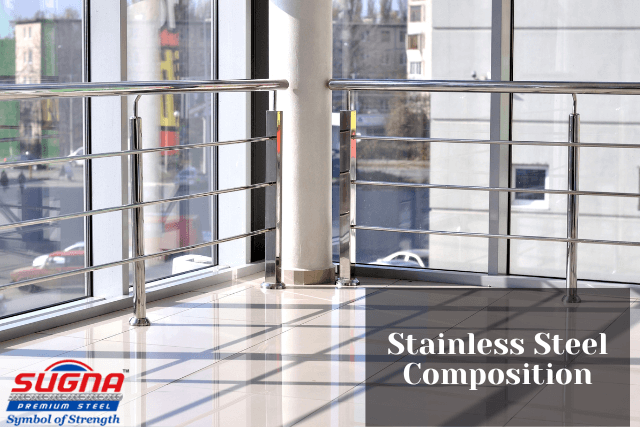There are about 150 different grades of steel, but only 15 of them are often utilized. The most common material used to make kitchen utensils is stainless steel because it doesn’t alter the flavor of food and is simple to clean.
It is used to produce hardware, plates, sheets, bars, wire, medical tools, food utensils, industrial equipment, and building construction components.
Considering the use of stainless steel, I thought about creating a brief blog post about the fundamental makeup of steel and the five primary grades that make up stainless steel. So, let’s quickly review the fundamental composition of steel and its common types.
Stainless Steel Composition

A metal alloy called stainless steel may be created by combining steel with other elements like silicon, aluminum, chromium, nickel, molybdenum, and carbon. The fundamental component of chrome steel is iron, which is combined with carbon to produce steel.
To make it resistant to corrosion, chromium is added. In the event of aggressive usage, the addition of nickel improves corrosion-resistant qualities. Molybdenum is used to provide scar resistance against localized corrosion.
Additional alloying metals, such as copper, titanium, and vanadium, are also added to stainless steel to further improve its properties and structure. Based on its composition, steel is divided into one of five stainless steel families.
Top Five Classification of Steel based on the Composition
The metallurgical microstructure of these families gives rise to their names. The five main classifications of stainless steel based on composition are given below:
1. Iron-based Stainless Steel
Ferritic stainless steel is also referred to as “plain’ chromium steel due to the absence of further alloying components. They contain between 12 and 18% chromium. Ferritic stainless steel has a very low carbon content.
Top features of iron-based stainless steel:
- It can withstand moderate rusting.
- It possesses resistance to stress corrosion.
- It cannot be hardened by heating.
The most popular ferritic grades are grade 409 stainless steel and grade 430 stainless steel, which is patented.
2. Austenitic Stainless Steel
If enough nickel is added to stainless steel, the microstructure becomes “austenite.” Austenitic stainless steel makes up 70% of the material’s commercial production. The austenitic stainless steel grade that is used the most is 304. (1.4301).
Furthermore, more than half of the stainless steel that is commonly used is named grade 304. This alludes to the typical composition, which contains 8% nickel and 18% chromium.
Top features of austenitic stainless steel:
- It has excellent corrosion resistance.
- It can quickly harden with cold labor.
- The heat treatment cannot harden anything.
- It is durable and easily sculptable.
- It performs admirably in hot environments.
Along with 304 stainless steel, other common austenitic grades include the well-liked marine grade, 316 stainless steel, and the machining bar grade, 303 stainless steel.
3. Martensite Stainless Steel
Martensitic stainless steel was the first type of stainless steel created for industrial use. Cutlery was made using these steels. The martensitic stainless group has a comparatively high carbon content (0.1–1.2%) compared to other types of stainless steel.
Similar to ferritic stainless steel, these are simple chrome steels with a chromium concentration of between 12 and 18%.
Top characteristics of martensitic stainless steel:
- It is somewhat resistant to rusting.
- It can be heated.
- It is unable to form quickly.
420 stainless steel, a type of martensitic steel that is largely utilized in engineering applications like shafts, is one such material. Furthermore, 440C stainless steel is the hardest and most resistant stainless steel available.
4. Duplex Stainless Steel
The microstructure of duplex stainless steel, which has both a ferritic and an austenitic component, gives it its name. Between 18 and 28% of them have a comparatively high chromium content. Nickel concentration is moderate at 4.5 to 8%.
The nickel percentage is too low at this point to produce a fully austenitic structure. As a result, a duplex microstructure with ferritic and austenitic phases is produced. Molybdenum content in duplex stainless steel typically ranges from 2.5 to 4%.
Top features of duplex stainless steel:
- It has excellent resistance against corrosion.
- It is stronger in tensile strength and yield than austenitic or ferritic grades.
- It has excellent weldability.
- It has excellent formability.
5. Precipitation Hardening of Stainless Steel
Martensitic, semi-austenitic, or austenitic stainless steel can precipitation harden. Alternatively, they have a combination of martensitic and austenitic stainless steel features. Such as heat treatability under martensitic steels and corrosion resistance under austenitic steels.
Precipitation-hardening grades, such as 17-4 PH, are offered as solution-treated bars (also known as 630 stainless steel). Then, they can be machined before they harden. A single low-temperature aging stage constitutes the hardening process.
Top features of precipitation hardening in stainless steel:
- It has good to moderate resistance to rusting.
- It has excellent weldability.
- It is extremely powerful and magnetic.
Related Posts:
- What Is The Density Of Steel?
- What Are Mini Steel Plants?
- Which Is More Elastic Rubber Or Steel?
- Mild Steel vs High Steel
Bottom Line
Due to its exceptional corrosion resistance, high strength, and appealing look, stainless steel components are used in both industrial and consumer markets. This blog post should have provided a succinct overview of the five main types of stainless steel components.

